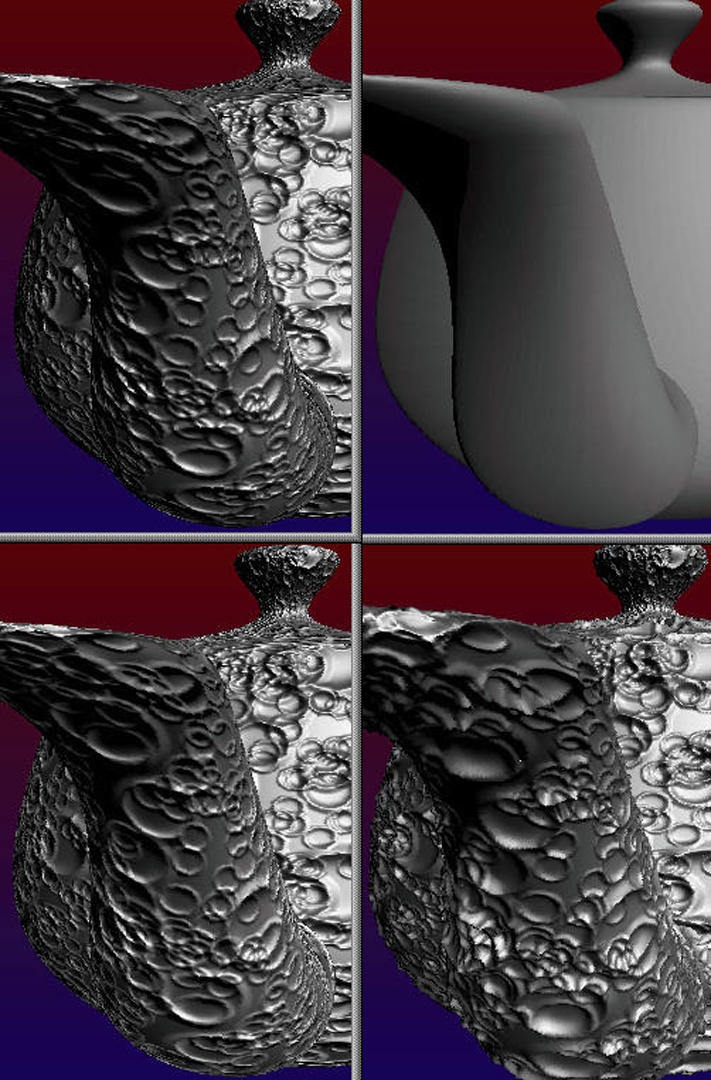“Smooth transitions between bump rendering algorithms” by Becker and Max
Conference:
Type(s):
Title:
- Smooth transitions between bump rendering algorithms
Presenter(s)/Author(s):
Abstract:
A method is described for switching smoothly between
rendering algorithms as required by the amount of visible surface detail. The result will be more realism with
less computation for displaying objects whose surface
detail can be described by one or more bump maps. The
three rendering algorithms considered are a BRDF,
bump mapping, and displacement mapping. The bump
mapping has been modified to make it consistent with
the other two. For a given viewpoint, one of these
algorithms will show a better trade-off between quality, computation time, and aliasing than the other two.
The decision as to which algorithm is appropriate is a
function of distance, viewing angle, and the frequency
of bumps in the bump map.
References:
1. B. BECKER. Smooth transitions between bump rendering algorithms during animation. Master’s thesis, University of California at Davis, December 1992.
2. J. F. BLINK. Models of light reflection for computer synthesized pictures. J. George, Ed., vol. 11,192-198.
3. B. CABRAL, N. MAX, AND R. SPRINGMEYER. Bidirectional reflection functions from surface bump maps. In Computer Graphics (SIGGRAPH ’87 Proceedings) (July 1987), M. C. Stone, Ed., vol. 21,273-281.
4. R.L. COOK. Shade trees. In Computer Graphics (SIGGRAPH ’84 Proceedings) (July 1984), H. Christiansen, Ed., vol. 18, 223-231.
5. R. L. COOK, L. CARPENTER, AND E. CATMULL. The Reyes image rendering architecture. In Computer Graphics (SIC- GRAPH ’87 Proceedings) (July 1987), M. C. Stone, Ed., 95- 102.
6. R. L. COOK AND K. E. TORRANCE. A reflectance model for computer graphics, vol. 15,307-316.
7. A. FOURNIER. Normal distribution functions and multiple surfaces. In Graphics Interface ’92 Workshop on Local Illumination. 1992, pp. 45-52.
8. J. T. KAJIYA. Anisotropic reflection models. In Computer Graphics (SIGGRAPH ’85 Proceedings) (July 1985), B. A. Barsky, Ed., vol. 19, 15-21.
9. N. L. MAX. Horizon mapping: shadows for bump-mapped surfaces. The Visual Computer 4, 2 (July 1988), 109-117.
10. N. L. MAX AND B. BECKER. Bump shading for volume textures. IEEE Computer Graphics and Applications (1993). To appear.
11. K. PERLIN. A unified textural reflectance model. Advanced Image Synthesis course notes, SIGGRAPH ’84, July 1984.
12. K. PERLIN. An image synthesizer. In Computer Graphics (SIGGRAPH ’85 Proceedings) (July 1985), B. A. Barsky, Ed., vol. 19, 287-296.
13. K. TORRANCE AND E. SPARROW. Theory for off-specular reflection from roughened surfaces. Journal of the Optical Society of America 57, 9 (1967), 1105-1114.
14. S. H. WESTIN, J. R. ARVO, AND K. E. TORRANCE. Predicting reflectance functions from complex surfaces. In Computer Graphics (SIGGRAPH ’92 Proceedings) (July 1992), E. E. Catmull, Ed., vol. 26,255-264.
15. L. WILLIAMS. Casting curved shadows on curved surfaces. In Computer Graphics (SIGGRAPH ’78 Proceedings) (August 1978), vol. 12, 270-274.




